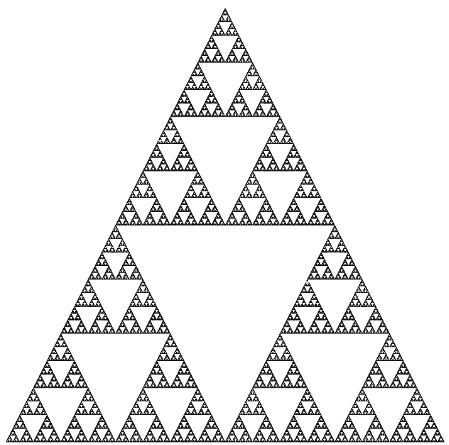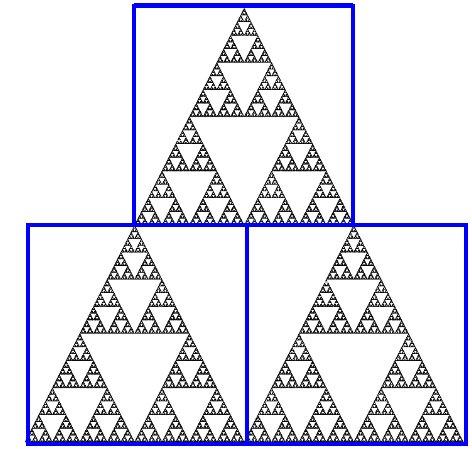Iterated Function Systems
CS 481/681 2007 Lecture, Dr. Lawlor
An Iterated Function System
(IFS) is a really simple object. It's just a small set of
matrices, or other space-to-space functions (hence usually called
"maps"). It's really easy to describe lots of interesting fractal
shapes using IFSs, where the shape consists of nothing but a set of
scaled copies of itself. That is, an IFS is a definition for a
sort of "recursive object", where you define the object in terms of
smaller copies of itself.
For example, a Sierpinski Triangle consists of three smaller Sierpinski
Triangles. Hence you can represent a Sierpinski Triangle using an
IFS with 3 matrices that map the unit square down onto the three pieces.
You can draw an IFS by recursively applying the IFS matrices, like
this. Eventually you do need a recursive base case, where you
draw a point or dot or... anything, really!
void drawSierpinski(Matrix cur) {
if (coordinates_are_really_small(cur))
{ /* Recursion base case: draw a little dot at this coordinate origin */
draw_a_point(cur);
} else { /* Recursion case */
drawSierpinski(cur*top_and_center);
drawSierpinski(cur*down_and_left);
drawSierpinski(cur*down_and_right);
}
}
Or if you've got a list of matrices, the same recursion looks like this:
void drawIFS(Matrix cur,int level,const std::vector<Matrix> &matrices) {
if (level>10)
{ /* Recursion base case: draw a little dot at this coordinate origin */
draw_a_point(cur);
} else { /* Recursion case */
for (int m=0;m<matrices.size();m++)
drawSierpinski(cur*matrices[m], level+1, matrices);
}
}
What's really weird about IFSs is that *there is no geometry
there*. It's all just points, defined by a small set of matrices.
Curiously, you can also draw an IFS without recursion by applying a randomly chosen IFS matrix to a randomly-chosen point:
void diceIFS(const std::vector<Matrix> &matrices) {
Point p=Point(0,0);
for (int i=0;i<1000000;i++) {
p=matrices[rand()%matrices.size()] * p;
draw_a_point(p);
}
}
You can define IFSs in any number of dimensions; see some 3D examples in an online Java Applet.
I wrote a paper in late 2002 describing how to find bounding volumes for 2D and 3D IFS.
The same page has presentations, a much nicer 2D IFS editor than my 3D
version on the course homepage, and a whole set of cool 2D IFSs.



